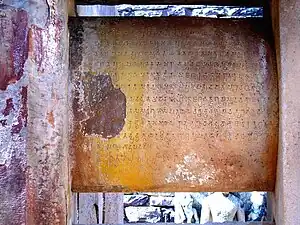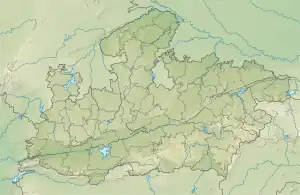Sanchi inscription of Chandragupta II
The Sanchi inscription of Chandragupta II is an epigraphic record documenting a donation to the Buddhist establishment at Sanchi in the reign of king Chandragupta II (circa CE 375–415). It is dated year 93 in the Gupta era.
| Sanchi inscription of Chandragupta II | |
|---|---|
 The inscription of Gupta ruler Chandragupta II at Sanchi. | |
| Material | Stone |
| Created | circa 375–415 CE |
| Present location | Sanchi, Raisen, India |
 Sanchi  Sanchi | |
Location
Sanchi is located in Raisen District, Madhya Pradesh, India. The inscription is in situ on railing of the main stūpa, to the immediate left of the eastern gate.
Publication
After early notices in the time of James Prinsep, the inscription was published by John Faithfull Fleet in 1888.[1] For later editions and translations, see The South Asia Inscriptions Database.
Historical Significance
The inscription is important for the history of Sanchi because it was added to the outer railing, a part of the monument generally dated to circa 100 BCE. It therefore registers a donation to a religious site that was at least five centuries old when the gift was made. The historical significance of the inscription as a document of inter-religious tolerance has been explored by Hans T. Bakker.[2]
Text
The text is in Sanskrit and available through The South Asia Inscriptions Database, see external links.
Translation
"Perfection has been attained! To the community of the faithful in the holy great vihâra of Kâkanâdabôta, -in which the organs of sense (of the members of it) have been subdued by the virtues of (good) character, religious meditation, and wisdom; which . . . . . . . . . . . . deeds of the very highest religious merit; which has come together from the four quarters of the world; (and) which is the abode of most excellent Shramanas,-having prostrated himself in an assembly of five persons, Amrakârdava the son of Undâna,-whose means of subsistence have been made comfortable by the favour of the feet of the Mahârâjâdhirâja, the glorious Chandragupta (II.); who is publishing in the world the amiable behaviour of the virtuous people who are the dependents (of the king); who has acquired banners of victory and fame in many battles; (and) who is an inhabitant of (the town of) Nashtî . . . . . . in the Sukuli dêsha,-gives (the village or allotment of) Îshvaravâsaka ……..purchased with the endowment of Maja and Sharabhanga and Amrarâta of the royal household, and (also gives) twenty-five dînâras.
(Line 7.)-From [the interest of the dînâras] given by him,- with half, as long as the moon and the sun (endure), let five Bhikshus be fed, and let a lamp burn in the jewel-house, for the perfection of all the virtues of….the familiar name of Dêvarâja, ……. Of the Mahârâjâdhirâja, the glorious Chandragupta (II.); and with the other half, which is mine, let the same number of five Bhikshus be fed, and (let) a lamp (burn) in the jewel-house.(L. 10.)-Whosoever shall interfere with this his arrangement,- he shall become invested with (the guilt of) the slaughter of a cow or of a Brâhman, and with (the guilt of) the five sins that entail immediate retribution!
(L. 11.)-The year 90 (and) 3; (the month) Bhâdrapada; the day 4.— Sanchi inscription of Chandragupta II
See also
Notes
- J. F. Fleet, Inscriptions of the Early Gupta Kings, Corpus Inscriptionum Indicarum, Vol. III. (Calcutta: Government of India, Central Publications Branch, 1888), pp. 32-34.
- Hans T. Bakker, "Royal Patronage and Religious Tolerance The Formative Period of Gupta–Vākāṭaka Culture," Journal of the Royal Asiatic Society 20.4 (2010): pp. 461– 475. Text only archived here: http://doi.org/10.5281/zenodo.845642, for JRAS DOI: https://doi.org/10.1017/S1356186310000301.